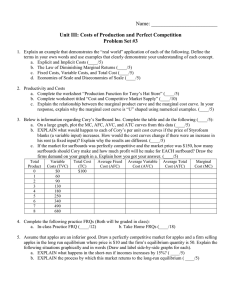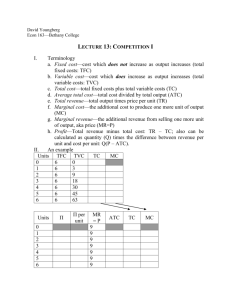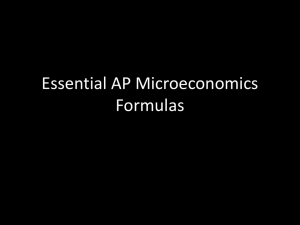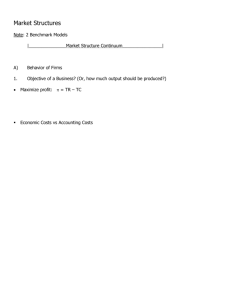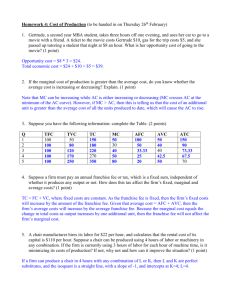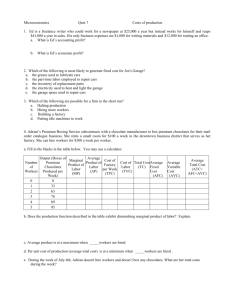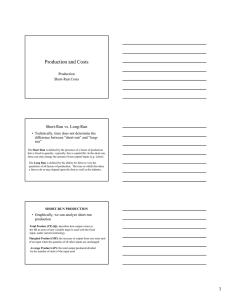Production and Cost
advertisement
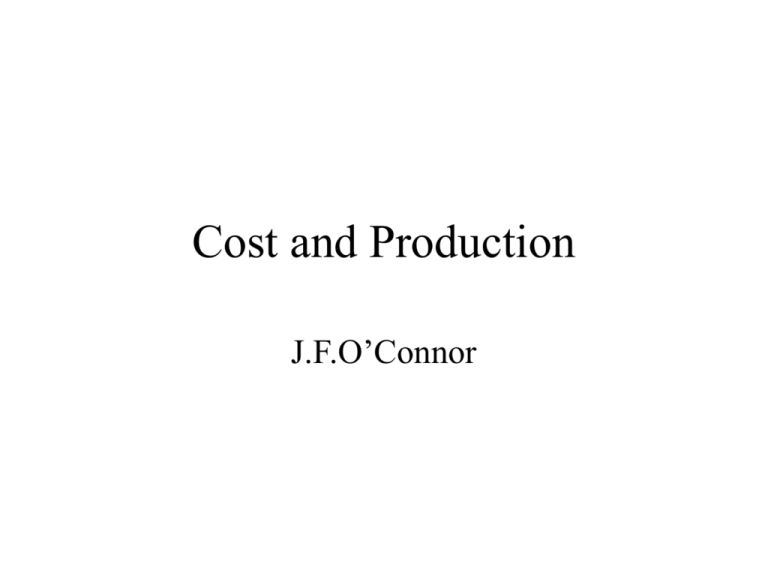
Cost and Production J.F.O’Connor Production Function • Relationship governing the transformation of inputs or factors of production into output or product. • Focus on one variable input. Relationship between output and the variable input is the total product (TP) curve. • An example similar to book’s is as follows: TotalProductCurve 140 120 Output 100 80 60 40 20 0 0 2 4 6 Labor 8 10 12 Three Questions • For any given level of employment of the input: • How much output is obtained? • What is the average output per unit of input? • If the employment of the input is changed by one unit what is the change in output? The Answers • The Total Product (TP) answers the first. • The Average Product (AP) of the input answers the second. It is AP=TP/L. • The Marginal Product answers the third. It is the change in total product divided by the change in the input, MP = [TP(L1)-TP(L0)]/(L1-L0) • The relevant quantities for our example are: In p u t O u tp u t A ve ra g e P ro d u c t M a rg in a l P ro d u c t L 0 1 2 3 4 5 6 7 8 9 10 11 TP 0 40 57 69 80 89 98 106 113 120 126 133 AP MP 4 0 .0 2 8 .3 2 3 .1 2 0 .0 1 7 .9 1 6 .3 1 5 .1 1 4 .1 1 3 .3 1 2 .6 1 2 .1 2 0 .0 1 4 .1 1 1 .5 1 0 .0 8 .9 8 .2 7 .6 7 .1 6 .7 6 .3 6 .0 The Unit Product Curves • The average and marginal products are plotted in the next graph. • Note that this example has diminishing marginal product for all ranges of input. • Since average product is declining, marginal is less than average at each level of employment of the input. Unit Product Curves 80 70 60 Output 50 40 30 AP 20 MP 10 0 0 2 4 6 Labor 8 10 12 Cost of Production • In order to obtain the information about the cost of producing various levels of output, we combine the information from the total product curve with that of input price. • The price of the input, labor, is $10 per unit. • Total variable cost (TVC) is obtained by multiplying the amount of input required by the price per unit. See first and third columns of the next table. L Q 0 0.125 0.25 0.5 1 2 3 4 5 6 7 8 9 10 11 TVC 0 14 20 28 40 57 69 80 89 98 106 113 120 126 133 0 1.25 2.5 5 10 20 30 40 50 60 70 80 90 100 110 FC 30 30 30 30 30 30 30 30 30 30 30 30 30 30 30 TC 30 31.25 32.5 35 40 50 60 70 80 90 100 110 120 130 140 AVC 0.000 0.088 0.125 0.177 0.250 0.354 0.433 0.500 0.559 0.612 0.661 0.707 0.750 0.791 0.829 AFC 0.000 ATC 0.000 1.500 1.061 0.750 0.530 0.433 0.375 0.335 0.306 0.283 0.265 0.250 0.237 0.226 1.625 1.237 1.000 0.884 0.866 0.875 0.894 0.919 0.945 0.972 1.000 1.028 1.055 MC 0.000 0.177 0.250 0.354 0.500 0.707 0.866 1.000 1.118 1.225 1.323 1.414 1.500 1.581 1.658 Total Costs (Cols 3-5) • Total variable cost (TVC) gives the minimum expenditure on variable inputs required to produce each level of output. • Fixed cost is the opportunity cost of the fixed inputs and does not vary with output. It is $30 in our example. • Total cost (TC) is the sum of total variable cost and fixed cost, TC = TVC + FC. • FC and TC are plotted in the next graph. TotalCostandFixedCost TC 140 120 Dollars 100 80 60 40 FC 20 0 0 20 40 60 80 Output 100 120 140 Profit Maximization • Profit is the difference between total revenue and total cost. Total revenue is price of output times quantity of output. • The price of output is $1 per unit. • Total revenue is output times $1. We plot this in the next graph. It is a straight line of slope one. The vertical difference between TR and TC is profit. The maximum profit is at 80 units of output. Profit is $10. Profit Maximization TC 140 120 100 Dollars 80 60 40 FC 20 0 0 20 40 60 80 Output 100 120 140 Unit Costs • It is often more convenient to deal with per unit costs and revenues rather than the total quantities. There are four such quantities • Average variable cost, AVC = TVC/Q • Average fixed cost, AFC = FC/Q • Average total cost, ATC = AVC + AFC • Marginal cost: MC = (change in TC)/(change in Q) • All four are given in the Table and plotted: UnitCosts 1.800 1.600 MC $/unit 1.400 1.200 ATC 1.000 0.800 AVC AFC 0.600 0.400 0.200 0.000 0 20 40 60 80 Output 100 120 140 Profit Maximization, Again • If you are thinking of producing a given level of output, how do you decide whether or not you can do better in terms of profit? • Answer the question: Would a change in output increase profit? • For an increase of one unit, is the addition to total revenue greater than the addition to total cost? In our case, is price greater than marginal cost? If so, increase output. • For an decrease of one unit, is the reduction in revenue less than than the reduction in total cost? In our case, is price less than marginal cost? If so, decrease output. • Price of output equal to marginal cost is necessary for profit maximization. • If we were at 40 units of output, the addition to revenue is $1 and the addition to cost is $.5. Increasing output will increase profit. Continue increasing output until price = marginal cost, which is at 80 units. • We would arrive at the same decision by drawing a price line at $1 in the unit cost graph and locating the output at which price = marginal cost, namely, 80 units.
